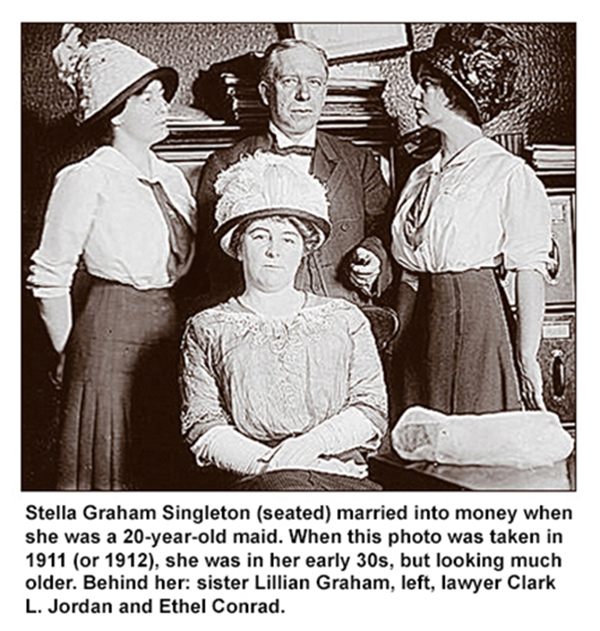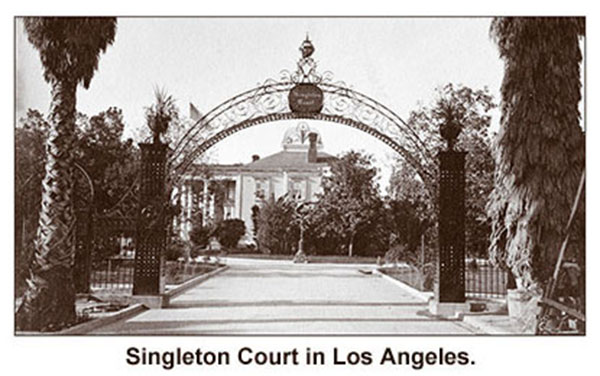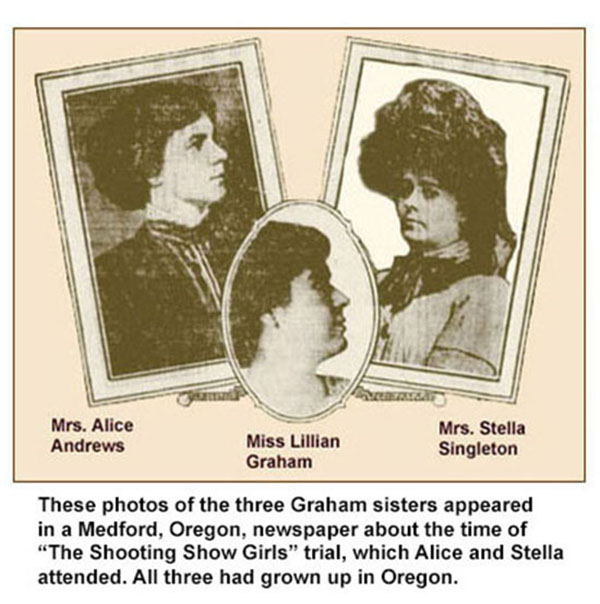| HOME • FAMILY • YESTERDAY • SOLVAY • STARSTRUCK • MIXED BAG |
 |
|
|
|
 |
|
After Lillian Graham met W. E. D. Stokes at New York's Hotel Ansonia – and it was he who initiated the meeting; she was 18 years old, he was 54 – she might have thought she could follow the example of her older sister, Stella, and marry a millionaire. Google John Singleton of Yellow Aster mine fame, and you'll find several opportunities to read an interesting story by Sam Watters, an architectural historian, author of the book "Houses of Los Angeles" and a columnist for the Los Angeles Times. A fellow named John Singleton made his millions from the Yellow Aster gold mine in Randsburg, California, which was in no man's land, north-by-northwest of Los Angeles, about halfway to the Nevada border. In 1900 Singleton was 53-year-old, divorced, and the owner of a Los Angeles mansion. Stella Graham, just 20 at the time, may have been working as a maid for Singleton, which makes the following seem like a Cinderella story. Writes Watters: "Singleton hired William H. Hill of Pasadena to photograph his house, stable and garden. Black-and-white-photo albums were to the 19th century what Facebook is to the 21st. Transportable and reproducible, they were perfect for bragging to a prospective spouse. With sharply focused portraits of decorated interiors and landscaped grounds, Singleton created a leather-bound volume and stamped on its cover: Singleton Court. He inscribed the opening page: 'A memento, to Stella, from Singleton.' "Stella Graham was just 20 when she received Singleton's album. Its pages conjured up a world of Champagne taste that could be hers if only she'd marry the millionaire miner. Handwritten captions pointed to highlights in each photo. Singleton boasted of a 'pair of rare old bronze Japanese vases,' a summer house, a blooming jacaranda, a carriage and a one-horse roadster. There was the Mexican helper, the liveried driver and the boss himself, suited up in front of the mansion. "In 1901, he and Graham married in San Francisco and honeymooned in Hawaii before moving to Singleton Court." Unfortunately this was not a fairy tale nor a romantic movie with an upbeat ending. In 1902 Singleton's only son, Edward, shot himself to death at Singleton Court. Four years later the mansion was destroyed by fire. The marriage stumbled and the couple went their separate ways, at least for while. Stella Graham Singleton spent some time in Europe. Her sister Lillian lived with her for awhile there. Judging by some of the letters written to Lillian Graham by W. E. D. Stokes, Mr. and Mrs. Singleton remained married and affected a reconciliation of sorts. I believe Singleton is the person referred to in those letters as "The Colonel." |
|
 |
|
Singleton died at Yellow Aster in 1914, and Graham remarried twice after that. The house at Singleton Court was never rebuilt. Since finding that Sam Watters story, I have found out more about Stella and John Singleton. And like many others I've come across during my detour, this story is almost too strange to be true. |
|
 |
|
First a doll, then a daughter Lillian Graham isn't mentioned here, but at the time she might well have been living at the Ansonia with her sister, Stella, and brother-in-law. This story is both heartwarming and a bit disturbing, what with an abandoned little girl being given into the custody of a couple of strangers so soon after she was found, strangers who were headed for Paris. Well, at least Mrs. Singleton was. Had the authorities investigated the adoptive parents, they would have discovered the couple was on the verge of a separation that would lead to a divorce about a year later. |
|
|
Mrs. Stella Singleton went to Europe with her daughter, whom she named Lillian. She seemed to divide her time between Paris and Brussels, where she later enrolled her daughter in a convent. For awhile, after her divorce, Mrs. Singleton toyed with the idea of living at the convent herself, hoping to be a lay nun. Lillian Graham spent a lot of time in Paris, too, before she returned to the United States a few months before she had her fateful encounter with her former lover, W. E. D. Stokes. |
|
| HOME | CONTACT |

